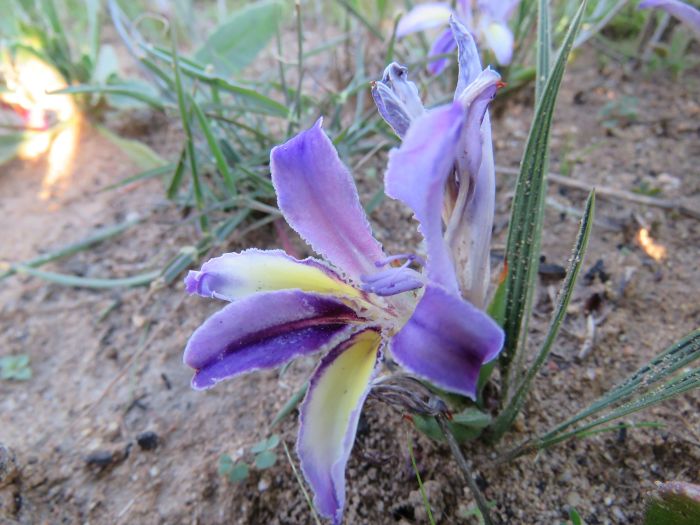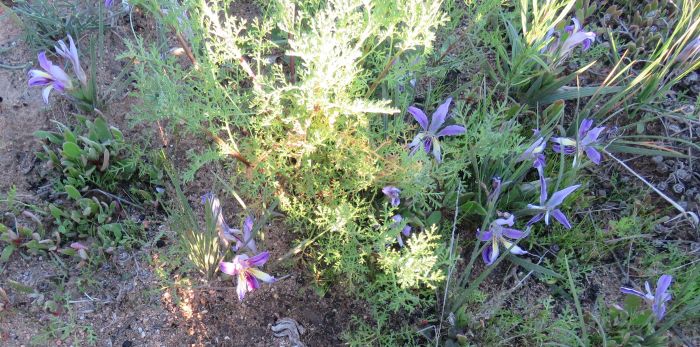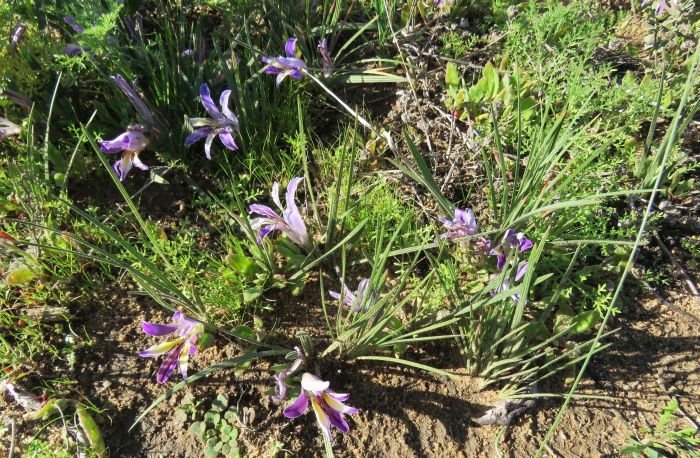Babiana sambucina subsp. sambucina
Babiana sambucina (Jacq.) Ker Gawl. subsp. sambucina
Family: Iridaceae
Common names: fragrant babiana (Eng.); bobbejaantjie (Afr.)
Introduction
Babiana sambucina subsp. sambucina is an attractive, dwarf, spring-flowering bulbous plant, which is drought tolerant and water-wise.

Description
Description
This winter-growing, perennial, cormous geophyte is 50–140 mm high, with the stem mostly underground and shorter than the leaves. It has narrow, ribbed, sword-shaped leaves that are 140 mm long and are sometimes hairy. The strongly violet-scented, blue to purple flowers are zygomorphic (flowers that can be divided into equal halves along only one line; bilaterally symmetrical), up to 60 mm in diameter, have a gradually flaring, straight flower tube of 30–65 mm long, borne on a short compact spike, bunched together at ground level. The lower tepals (no distinction can be made between petals and sepals) are unequal, white, with sometimes red markings acting as nectar guides. Flowering occurs mainly in winter and spring, between July to September. The flowers are long-lasting and close at sunset. The ripe fruit is a globose, membranous capsule, which splits longitudinally, allowing dispersal of the numerous dark brown, irregularly angled, wrinkled seeds.
Babiana sambucina subsp. sambucina varies much between populations across its wide range: in leaf form, degree of hairiness, flower markings and flower tube length.
Conservation Status
Status
Babiana sambucina subsp. sambucina is assessed as Least Concern (LC) according to SANBI’s Red List of South African plants. The population of the species is stable and, therefore, not endangered.

Distribution and habitat
Distribution description
This babiana is found over a wide range, extending from the Cold Bokkeveld Mountains in the Western Cape to Port Elizabeth in the Eastern Cape, including the Karoo. It grows on rocky slopes and flats, in dry fynbos and renosterveld, most often on sandstone slopes, in soils which are nutrient-poor, at altitudes of 650–1 150 m. The population in Worcester experiences an average annual rainfall of 250 mm and temperatures reaching -1ºC.

Derivation of name and historical aspects
History
The genus name Babiana is derived from the Dutch baviaantje, meaning ‘little baboon’. The origin of the genus name and the Afrikaans common name, bobbejaantjie (little baboon), refers to the belief that the corms were a favourite food of baboons. The species name sambucina comes from the Latin sambucinus relating to the elderberry, Sambucus, the fruits of which were used to produce a blue dye, thus referring to the flower colour.
The genus comprises some 88 species, 5 of which occur in the Klein Karoo. It is easy to recognize members of this genus, for almost all the species have softly hairy and velvety leaves that are pleated or ribbed. The distinctive fibrous tunics also allow the genus to be recognized by the corms alone.
Other noteworthy members are Babiana villosa (with its spectacular red or pink flowers), B. hirsuta (with its bright red, 2-lipped flowers) and B. radiata (with large cerise-pink to mauve-blue flowers).

Ecology
Ecology
Chacma baboons enjoy feasting on the corms, so do porcupines and francolins. This is why the corms are deep seated, buried over 10 cm below ground level, thus protecting them from predation. Insect grubs make holes (tunnels) into the corms and feed on it before reaching adulthood.
Molerats also play an active role in local dispersal of the corms, thereby increasing the range of the species. The corms are transported to their nests, where they store food, and while carrying the corms and their attached leaves around, the cormlets fall randomly in the underground tunnels leading to the nests. In a year, plants may become dispersed over many metres. In the short term, this pattern of vegetative dispersal is valuable for the survival of a species.
The leaves of the Iridaceae family are edible but they appear to be unattractive to grazing animals (herbivores) because of their tough, fibrous nature or unappetizing appearance. The flowers are pollinated by monkey beetles belonging to the genus Anisonyx ursus. These beetles visit flowers for nectar, pollen and mating.

The ripe seeds are shaken out of their capsules by wind.
This bulbous plant has an underground storage organ that allows it to become dormant and thus survive the heat and drought of the summer.
Uses
Use
In the past, the indigenous peoples of southern Africa collected and roasted the corms, which have a pleasant nutty flavour.
The brightly coloured flowers will attract insects, like monkey beetles to the garden. There are no medicinal uses recorded for this plant.

Growing Babiana sambucina subsp. sambucina
Grow
Babiana sambucina subsp. sambucina requires a sunny spot for much of the day and is ideal for deep containers or a rock garden.
Sow seeds thinly in autumn, to prevent overcrowding and the formation of damping-off fungi, into deep containers, in a well-drained medium of equal parts of coarse river sand with fine compost. Keep moist by watering daily using a mist sprayer throughout the growing period. The seedlings must remain undisturbed for 2 years until strong enough, then they can be planted out into permanent containers or into the garden in the beginning of their third year. To reach flowering size, the seedlings may take 2–3 years.
In a rock garden, plant the corms in early autumn, with the top of the corm neck resting about 3 cm deep, in a growing medium of coarse river sand mixed with industrial sand (silica sand) and a little finely sifted, well-decomposed compost. To discourage the molerats from feasting on the starch-filled corms, plant euphorbia species, as their roots secrete an irritant in the soil.
Corms will take a year to flower. They like a thorough watering about twice per week in winter and spring, to prevent plants entering premature dormancy caused when the soil medium dries out too quickly. During the dormant season (summer) they must be kept dry. Remove the corm offsets (cormlets) produced in the underground leaf axils, when large enough. The cormlets can be stored dry until planting.
In a rock garden, Babiana sambucina subsp. sambucina can be planted together with taller growing bulbous species such as Lapeirousia anceps (Sandveld cabong), Cyanella hyacinthoides (blue lady’s hand), Gladiolus carinatus (yellow Afrikaner) and G. venustus (bright bonnet), Ornithogalum dubium (yellow chincherinchee) and inter-planted with spring-flowering annuals, such as Cleretum bellidiforme (Bokbaai vygies) and dwarf succulents such as Gonialoe variegata (kanniedood) and Aloe brevifolia (kleinaalwyn).
The Fusarium fungus, seen as reddish lesions, and mealy bug, attack the corms. To kill mealy bug, use methylated spirits diluted in water 1:1; dip an earbud in the solution and apply it onto these pests. In winter the leaves are susceptible to Fusarium dry rot and in early spring to red spider mite.
References
- Clarke, H. & Charters, M. 2016. The illustrated dictionary of southern African plant names. Flora & Fauna Publications Trust, Jacana, Johannesburg.
- Duncan, G.D. 2010. Grow bulbs. Kirstenbosch Gardening Series. South African National Biodiversity Institute, Cape Town.
- Goldblatt, P. & Manning, J. 2001. Bobbejaantjies: the genus Babiana. Veld & Flora Vol. 87(1): 12–15.
- Goldblatt, P. & Manning, J. 2007. A revision of the southern African genus Babiana, Iridaceae: Crocoidea. Strelitzia 18. South African National Biodiversity Institute, Pretoria.
- Innes, C. 1985. The world of Iridaceae: a comprehensive record. Holly Gate International, Ashington.
- Kesting, D. & Clarke, H. 2011. Botanical names: what they mean. Flora documentation programme, Muizenberg
- Manning, J. 2003. Photographic guide to the wildflowers of South Africa. Briza Publications, Pretoria.
- Manning, J., Goldblatt, P. & Snijman, D. 2002. The color encyclopedia of Cape bulbs. Timber Press, Cambridge.
- Vlok, J. & Schutte-Vlok, A-L. 2015. Plants of the Klein Karoo. Umdaus Press, Hatfield.
Credits
Shireen Harris
Karoo Desert National Botanical Garden
May 2019
Plant Attributes:
Plant Type: Bulb
SA Distribution: Eastern Cape, Western Cape
Soil type: Sandy
Flowering season: Spring
PH: Acid
Flower colour: Blue, Purple, Cream
Aspect: Full Sun
Gardening skill: Easy
Special Features:
Horticultural zones








Rate this article
Article well written and informative
Rate this plant
Is this an interesting plant?
Login to add your Comment
Back to topNot registered yet? Click here to register.